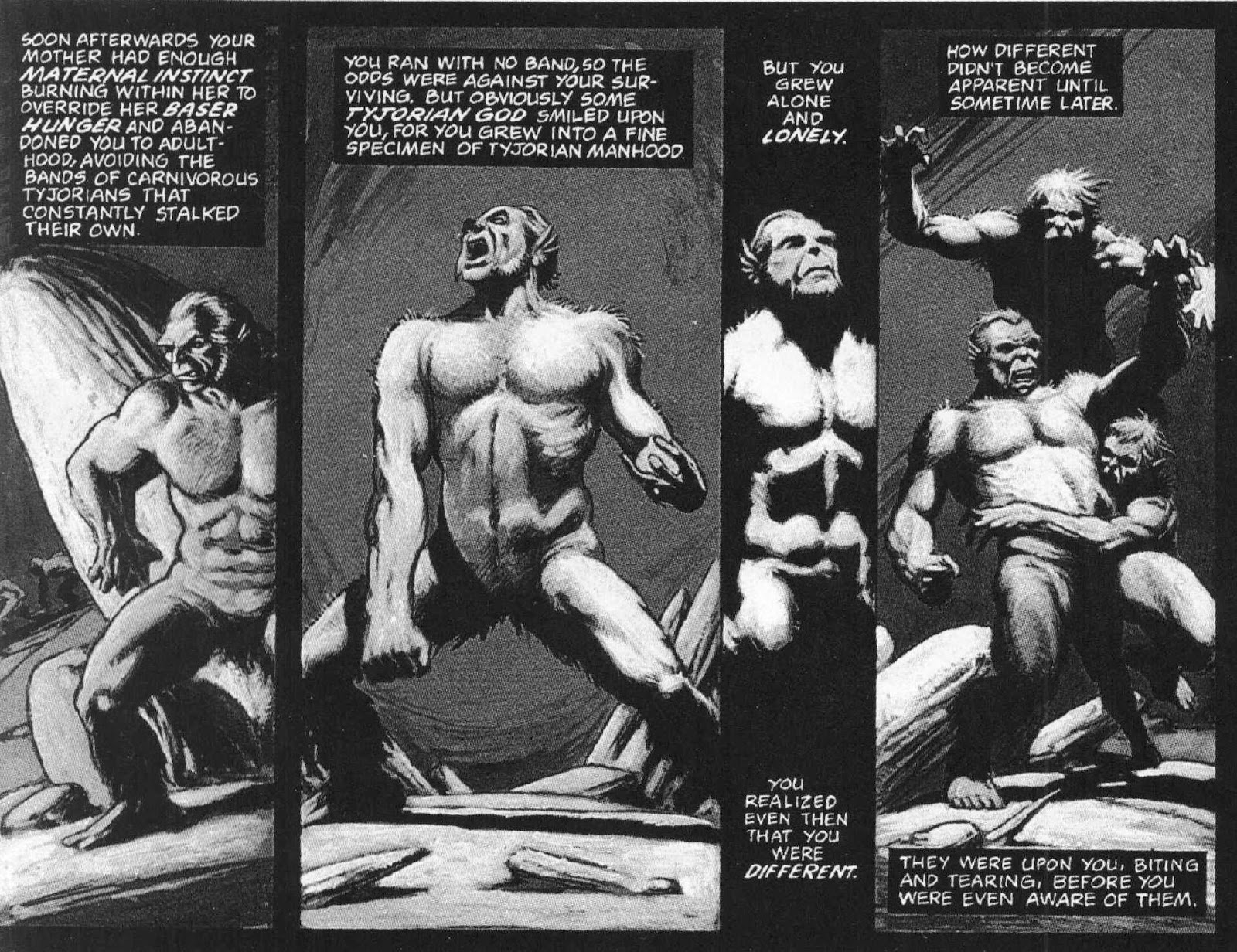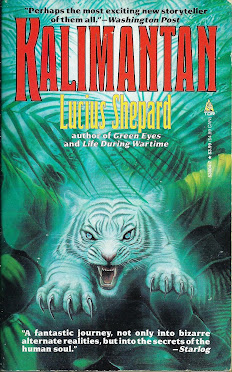Jim Starlin’s ‘Dreadstar’ comic books and graphic novels appeared on a regular basis throughout the 1980s, and since that time, have been reprinted in a bewildering number of volumes in different color formats from different publishers…… trying to sort out the contents of each of these compilations is no small task.
This Dynamite hardbound edition (2010; 230 pp) compiles all the Dreadstar material from ‘Metamorphosis Odyssey’, ‘The Price’ graphic novel, the ‘Dreadstar’ graphic novel, and the ‘Dreadstar’ chapter that appeared as a singleton adventure in Epic Illustrated. All of these works first appeared in the interval from 1980 – 1982.
This volume from Dynamite uses a high-quality, glossy paper stock. However, it is several inches smaller than the magazines and graphic novels the stories originally appeared in, so the typeface is comparatively cramped……and sometimes difficult to read.
This Dynamite hardbound edition (2010; 230 pp) compiles all the Dreadstar material from ‘Metamorphosis Odyssey’, ‘The Price’ graphic novel, the ‘Dreadstar’ graphic novel, and the ‘Dreadstar’ chapter that appeared as a singleton adventure in Epic Illustrated. All of these works first appeared in the interval from 1980 – 1982.
This volume from Dynamite uses a high-quality, glossy paper stock. However, it is several inches smaller than the magazines and graphic novels the stories originally appeared in, so the typeface is comparatively cramped……and sometimes difficult to read.
The whole 'Dreadstar' series started as a serial in Epic Illustrated magazine: ‘Metamorphosis Odyssey’, which appeared in the very first issue (the Spring, 1980 issue), and appeared in succeeding issues as 14 chapters, concluding with the December, 1981 issue. All of the artwork in the chapters was painted, some of it in black and white, and some in color.
‘Metamorphosis’ dealt with adventures in a galaxy far, far, away, a long, long time ago (the entire ‘Dreadstar’ canon borrows, not surprisingly, from ‘Star Wars’). The dread Empire of the Zygoteans is enslaving all civilizations in the galaxy; only the planet of the Osirosians is able to resist, but their resources are becoming depleted as a result of the 500-year conflict.
Among this team of heroes is the orphan Vanth, from the planet Byfrexia. Vanth is the equivalent of a Jedi Knight, equipped with a magic sword, superhuman strength, impressive spaceship piloting skills, and unmatched skills in hand-to-hand and ranged weapon combat.
I won’t disclose any spoilers, save to say that Vanth – soon
rechristened Vanth Dreadstar – plays a key role in the struggle against the
Zygotean onslaught.
In 1981 a quasi-sequel, titled ‘The Price’, was published by Marvel / Epic as a black-and-white graphic novel. ‘The Price’ was primarily
concerned with the adventures of Syzygy Darklock, the man who would become Vanth
Dreadstar’s mentor and ally.
‘The Price’ moves away from sf, and more into the type of magic-based adventures that characterized the world of Marvel Comic's 'Dr. Strange'.
‘The Price’ moves away from sf, and more into the type of magic-based adventures that characterized the world of Marvel Comic's 'Dr. Strange'.
The series’ next installment was ‘Dreadstar’, a Marvel
Graphic Novel published in 1982. Featuring color artwork, this volume centers
on the adventures of Vanth Dreadstar as he confronts – however unwillingly –
the need to deploy his martial skills in the ongoing conflict between the
Monarchy and the Instrumentality, the two major political blocs fighting for
control of the galaxy.
The 'Dreadstar: The Beginning' compilation concludes with an Epilogue, a ‘Dreadstar’
chapter that appeared in black-and-white in the December, 1982 issue (No. 15)
of Epic Illustrated. This chapter relates Dreadstar’s efforts to seize a
spaceship from an Instrumentality mining colony and contains a lot of flashback
sequences.
Starlin was presumably using this chapter as a teaser for the Dreadstar comic book series, which was inaugurated in November, 1982 by Epic Comics and eventually ran for 64 issues.
Starlin was presumably using this chapter as a teaser for the Dreadstar comic book series, which was inaugurated in November, 1982 by Epic Comics and eventually ran for 64 issues.
So, what do you get with this compilation of all the early adventures of the ‘Dreadstar’ franchise ? As I mentioned, it borrows to some degree from classic space opera and ‘Star Wars’, but it also incorporates the ‘cosmic’ perspective that Starlin routinely employed in his work during the 70s and 80s for Marvel titles like ‘Warlock’ and ‘Captain Marvel’, as well as the high-profile crossover series ‘Infinity Gauntlet’, and ‘Cosmic Odyssey’ for DC.
Dreadstar is not an action comic or a superhero comic; instead, it chooses to focus on a more wordy, cerebral approach, leading to panels that are overloaded with speech balloons and text boxes. This may turn off readers who are more accustomed to the minimalist, 'show, don't tell' formatting of contemporary comics.
Dreadstar is not an action comic or a superhero comic; instead, it chooses to focus on a more wordy, cerebral approach, leading to panels that are overloaded with speech balloons and text boxes. This may turn off readers who are more accustomed to the minimalist, 'show, don't tell' formatting of contemporary comics.
While there are occasional bloody battles between Dreadstar and Empire troops, much of the series’ contents are devoted to lengthy dialogues between various characters on a variety of ‘deep’ topics. There is always a note of ambiguity about the seemingly ‘right’ decisions that are made in the struggles against the forces of evil, and every victory comes with its cost. At times Starlin’s prose becomes too overwrought, and unconsciously comes a bit too close to self-parody, a phenomenon that characterized his efforts for ‘Warlock’, ‘Thanos’, and ‘Captain Marvel’.
By and large, however, if you appreciate a space opera with more depth than the genre is usually accredited, then this Dreadstar compilation is worth investigating. It’s also a welcome change from contemporary comics, in that Starlin takes pains to frame his plots using flashbacks and external narration, devices rarely present in modern comics, which often suffer from awkward lapses in visual and storytelling continuity.
As well, Starlin’s use of painted artwork, involving a canny use of different shadings of grays and whites for the black-and-white episodes, stands apart from contemporary comics and their flat, computer-assisted approach to illustration.














































































